Management Accounting Report: Principles, Systems, and Applications
VerifiedAdded on 2021/02/19
|21
|4381
|864
Report
AI Summary
This report offers a comprehensive overview of management accounting, encompassing key definitions, systems, and principles. It explores the differences between financial and management accounting, detailing the benefits and characteristics of effective management accounting systems. The report delves into cost analysis, including various cost types, cost volume profit analysis, flexible budgeting, and cost variance. It also covers inventory management, pricing strategies, and different types of budgets, along with alternative budgeting approaches and the behavioral implications of budgeting. Furthermore, the report discusses key performance indicators, financial governance, and the roles and characteristics of effective management accountants. It concludes by examining the development of strategies and systems for effective reporting and full disclosure within an organization. The report is a valuable resource for understanding the multifaceted nature of management accounting and its applications in strategic decision-making.
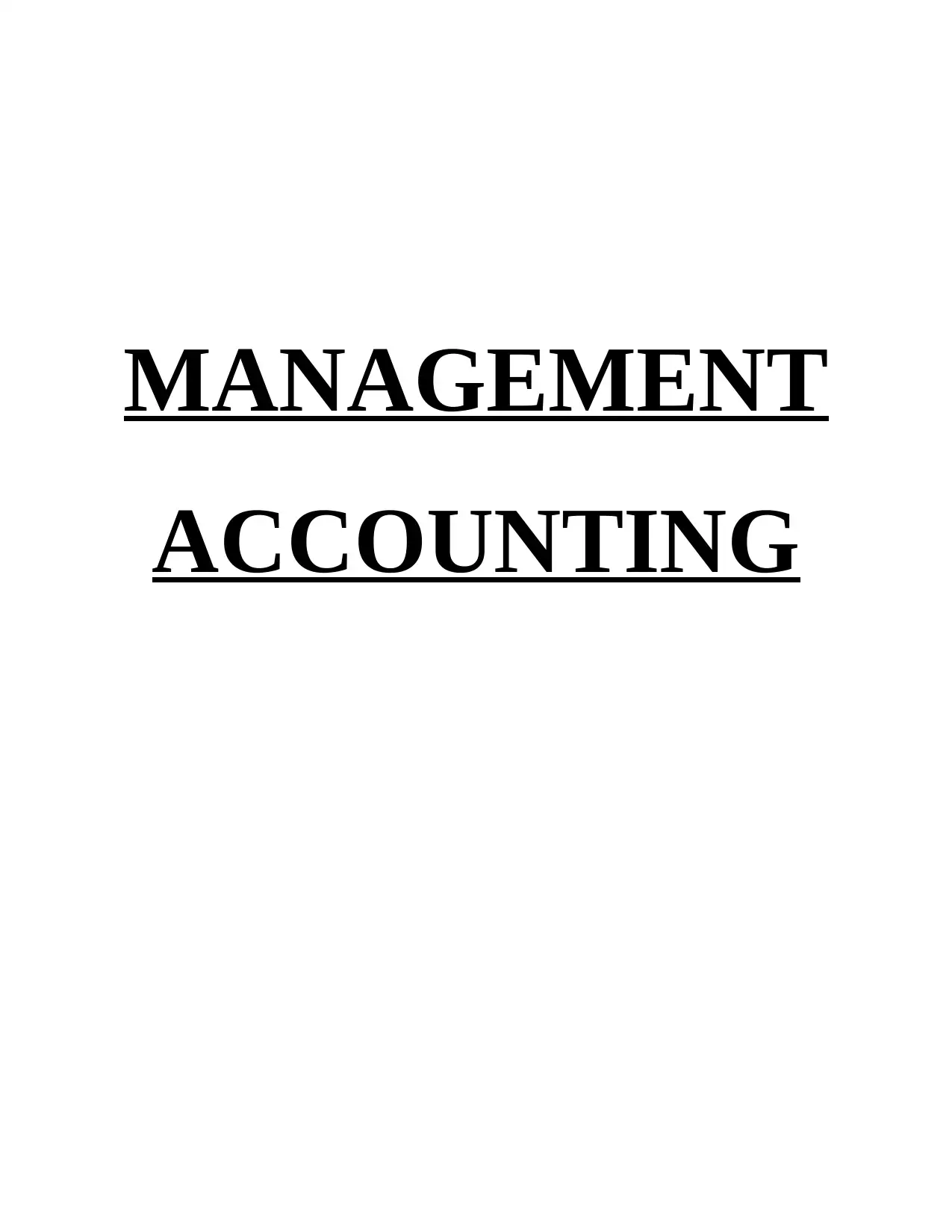
MANAGEMENT
ACCOUNTING
ACCOUNTING
Paraphrase This Document
Need a fresh take? Get an instant paraphrase of this document with our AI Paraphraser
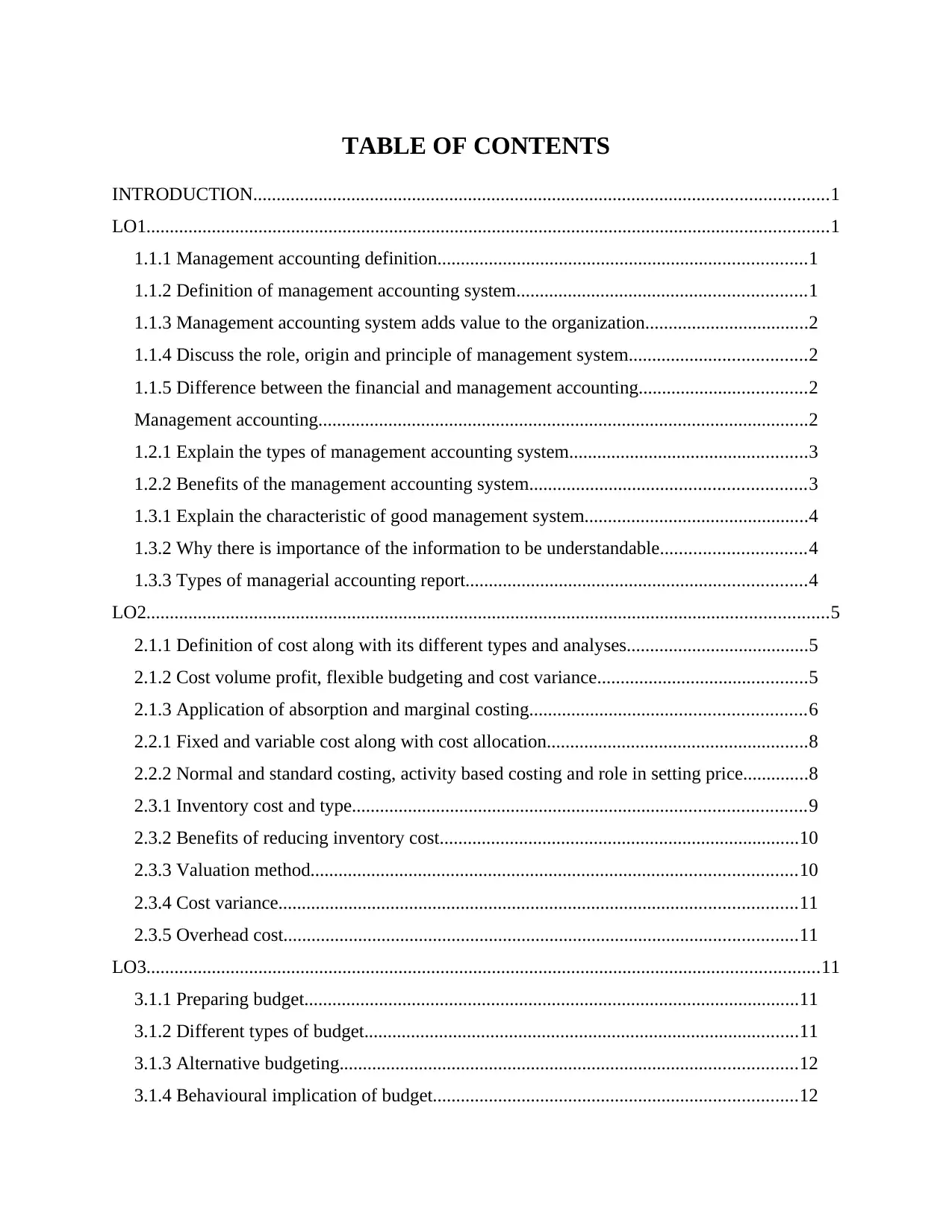
TABLE OF CONTENTS
INTRODUCTION...........................................................................................................................1
LO1..................................................................................................................................................1
1.1.1 Management accounting definition...............................................................................1
1.1.2 Definition of management accounting system..............................................................1
1.1.3 Management accounting system adds value to the organization...................................2
1.1.4 Discuss the role, origin and principle of management system......................................2
1.1.5 Difference between the financial and management accounting....................................2
Management accounting.........................................................................................................2
1.2.1 Explain the types of management accounting system...................................................3
1.2.2 Benefits of the management accounting system...........................................................3
1.3.1 Explain the characteristic of good management system................................................4
1.3.2 Why there is importance of the information to be understandable...............................4
1.3.3 Types of managerial accounting report.........................................................................4
LO2..................................................................................................................................................5
2.1.1 Definition of cost along with its different types and analyses.......................................5
2.1.2 Cost volume profit, flexible budgeting and cost variance.............................................5
2.1.3 Application of absorption and marginal costing...........................................................6
2.2.1 Fixed and variable cost along with cost allocation........................................................8
2.2.2 Normal and standard costing, activity based costing and role in setting price..............8
2.3.1 Inventory cost and type.................................................................................................9
2.3.2 Benefits of reducing inventory cost.............................................................................10
2.3.3 Valuation method........................................................................................................10
2.3.4 Cost variance...............................................................................................................11
2.3.5 Overhead cost..............................................................................................................11
LO3................................................................................................................................................11
3.1.1 Preparing budget..........................................................................................................11
3.1.2 Different types of budget.............................................................................................11
3.1.3 Alternative budgeting..................................................................................................12
3.1.4 Behavioural implication of budget..............................................................................12
INTRODUCTION...........................................................................................................................1
LO1..................................................................................................................................................1
1.1.1 Management accounting definition...............................................................................1
1.1.2 Definition of management accounting system..............................................................1
1.1.3 Management accounting system adds value to the organization...................................2
1.1.4 Discuss the role, origin and principle of management system......................................2
1.1.5 Difference between the financial and management accounting....................................2
Management accounting.........................................................................................................2
1.2.1 Explain the types of management accounting system...................................................3
1.2.2 Benefits of the management accounting system...........................................................3
1.3.1 Explain the characteristic of good management system................................................4
1.3.2 Why there is importance of the information to be understandable...............................4
1.3.3 Types of managerial accounting report.........................................................................4
LO2..................................................................................................................................................5
2.1.1 Definition of cost along with its different types and analyses.......................................5
2.1.2 Cost volume profit, flexible budgeting and cost variance.............................................5
2.1.3 Application of absorption and marginal costing...........................................................6
2.2.1 Fixed and variable cost along with cost allocation........................................................8
2.2.2 Normal and standard costing, activity based costing and role in setting price..............8
2.3.1 Inventory cost and type.................................................................................................9
2.3.2 Benefits of reducing inventory cost.............................................................................10
2.3.3 Valuation method........................................................................................................10
2.3.4 Cost variance...............................................................................................................11
2.3.5 Overhead cost..............................................................................................................11
LO3................................................................................................................................................11
3.1.1 Preparing budget..........................................................................................................11
3.1.2 Different types of budget.............................................................................................11
3.1.3 Alternative budgeting..................................................................................................12
3.1.4 Behavioural implication of budget..............................................................................12
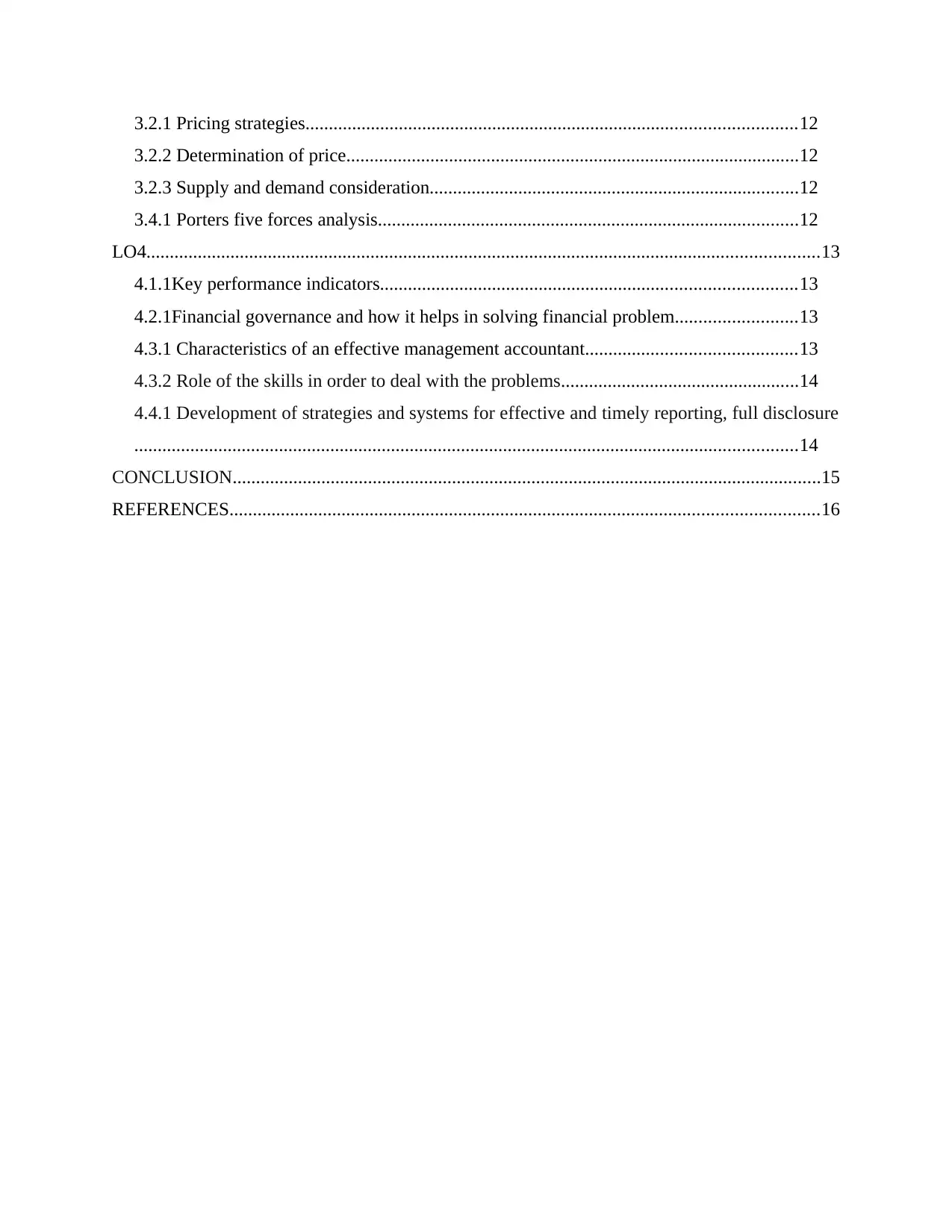
3.2.1 Pricing strategies.........................................................................................................12
3.2.2 Determination of price.................................................................................................12
3.2.3 Supply and demand consideration...............................................................................12
3.4.1 Porters five forces analysis..........................................................................................12
LO4................................................................................................................................................13
4.1.1Key performance indicators.........................................................................................13
4.2.1Financial governance and how it helps in solving financial problem..........................13
4.3.1 Characteristics of an effective management accountant.............................................13
4.3.2 Role of the skills in order to deal with the problems...................................................14
4.4.1 Development of strategies and systems for effective and timely reporting, full disclosure
..............................................................................................................................................14
CONCLUSION..............................................................................................................................15
REFERENCES..............................................................................................................................16
3.2.2 Determination of price.................................................................................................12
3.2.3 Supply and demand consideration...............................................................................12
3.4.1 Porters five forces analysis..........................................................................................12
LO4................................................................................................................................................13
4.1.1Key performance indicators.........................................................................................13
4.2.1Financial governance and how it helps in solving financial problem..........................13
4.3.1 Characteristics of an effective management accountant.............................................13
4.3.2 Role of the skills in order to deal with the problems...................................................14
4.4.1 Development of strategies and systems for effective and timely reporting, full disclosure
..............................................................................................................................................14
CONCLUSION..............................................................................................................................15
REFERENCES..............................................................................................................................16
⊘ This is a preview!⊘
Do you want full access?
Subscribe today to unlock all pages.

Trusted by 1+ million students worldwide
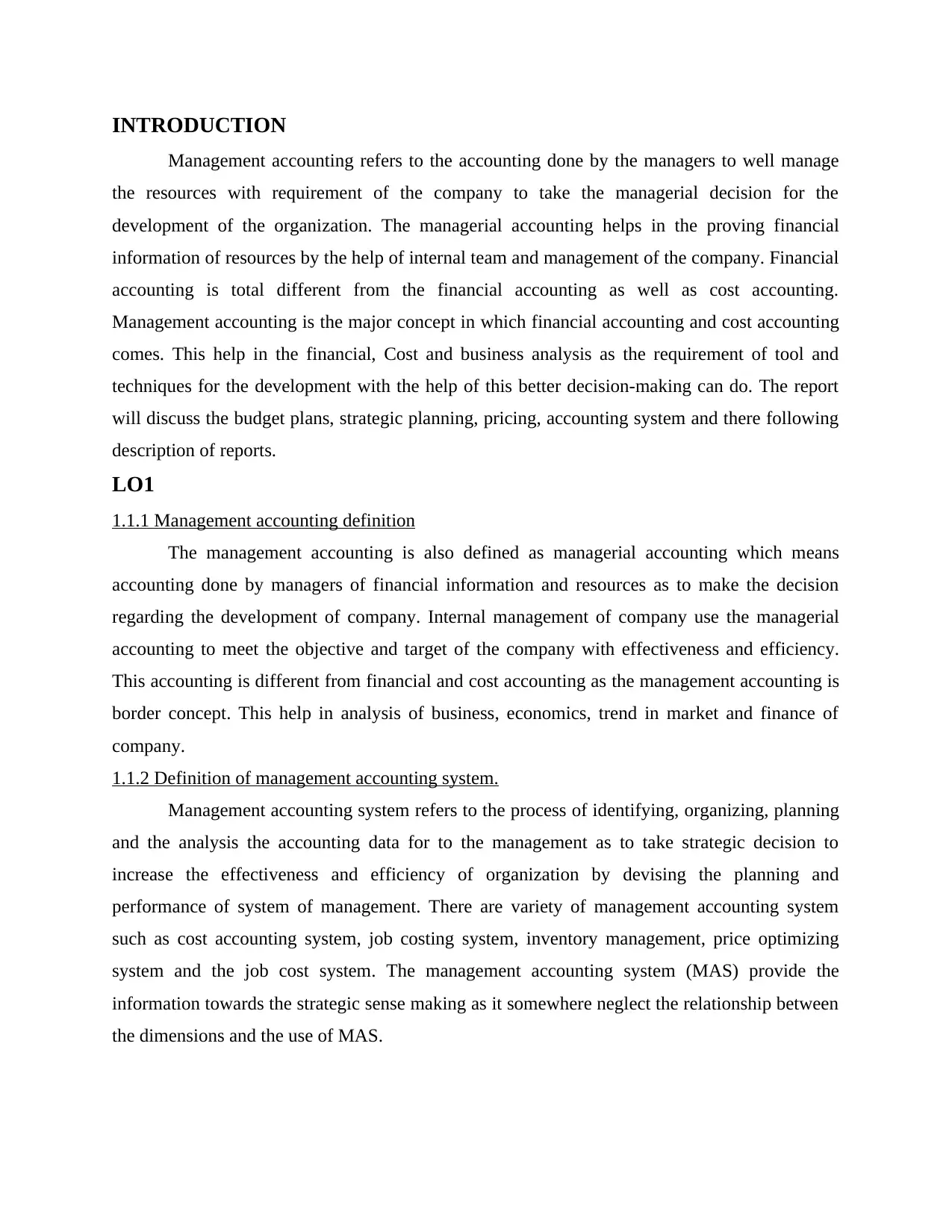
INTRODUCTION
Management accounting refers to the accounting done by the managers to well manage
the resources with requirement of the company to take the managerial decision for the
development of the organization. The managerial accounting helps in the proving financial
information of resources by the help of internal team and management of the company. Financial
accounting is total different from the financial accounting as well as cost accounting.
Management accounting is the major concept in which financial accounting and cost accounting
comes. This help in the financial, Cost and business analysis as the requirement of tool and
techniques for the development with the help of this better decision-making can do. The report
will discuss the budget plans, strategic planning, pricing, accounting system and there following
description of reports.
LO1
1.1.1 Management accounting definition
The management accounting is also defined as managerial accounting which means
accounting done by managers of financial information and resources as to make the decision
regarding the development of company. Internal management of company use the managerial
accounting to meet the objective and target of the company with effectiveness and efficiency.
This accounting is different from financial and cost accounting as the management accounting is
border concept. This help in analysis of business, economics, trend in market and finance of
company.
1.1.2 Definition of management accounting system.
Management accounting system refers to the process of identifying, organizing, planning
and the analysis the accounting data for to the management as to take strategic decision to
increase the effectiveness and efficiency of organization by devising the planning and
performance of system of management. There are variety of management accounting system
such as cost accounting system, job costing system, inventory management, price optimizing
system and the job cost system. The management accounting system (MAS) provide the
information towards the strategic sense making as it somewhere neglect the relationship between
the dimensions and the use of MAS.
Management accounting refers to the accounting done by the managers to well manage
the resources with requirement of the company to take the managerial decision for the
development of the organization. The managerial accounting helps in the proving financial
information of resources by the help of internal team and management of the company. Financial
accounting is total different from the financial accounting as well as cost accounting.
Management accounting is the major concept in which financial accounting and cost accounting
comes. This help in the financial, Cost and business analysis as the requirement of tool and
techniques for the development with the help of this better decision-making can do. The report
will discuss the budget plans, strategic planning, pricing, accounting system and there following
description of reports.
LO1
1.1.1 Management accounting definition
The management accounting is also defined as managerial accounting which means
accounting done by managers of financial information and resources as to make the decision
regarding the development of company. Internal management of company use the managerial
accounting to meet the objective and target of the company with effectiveness and efficiency.
This accounting is different from financial and cost accounting as the management accounting is
border concept. This help in analysis of business, economics, trend in market and finance of
company.
1.1.2 Definition of management accounting system.
Management accounting system refers to the process of identifying, organizing, planning
and the analysis the accounting data for to the management as to take strategic decision to
increase the effectiveness and efficiency of organization by devising the planning and
performance of system of management. There are variety of management accounting system
such as cost accounting system, job costing system, inventory management, price optimizing
system and the job cost system. The management accounting system (MAS) provide the
information towards the strategic sense making as it somewhere neglect the relationship between
the dimensions and the use of MAS.
Paraphrase This Document
Need a fresh take? Get an instant paraphrase of this document with our AI Paraphraser
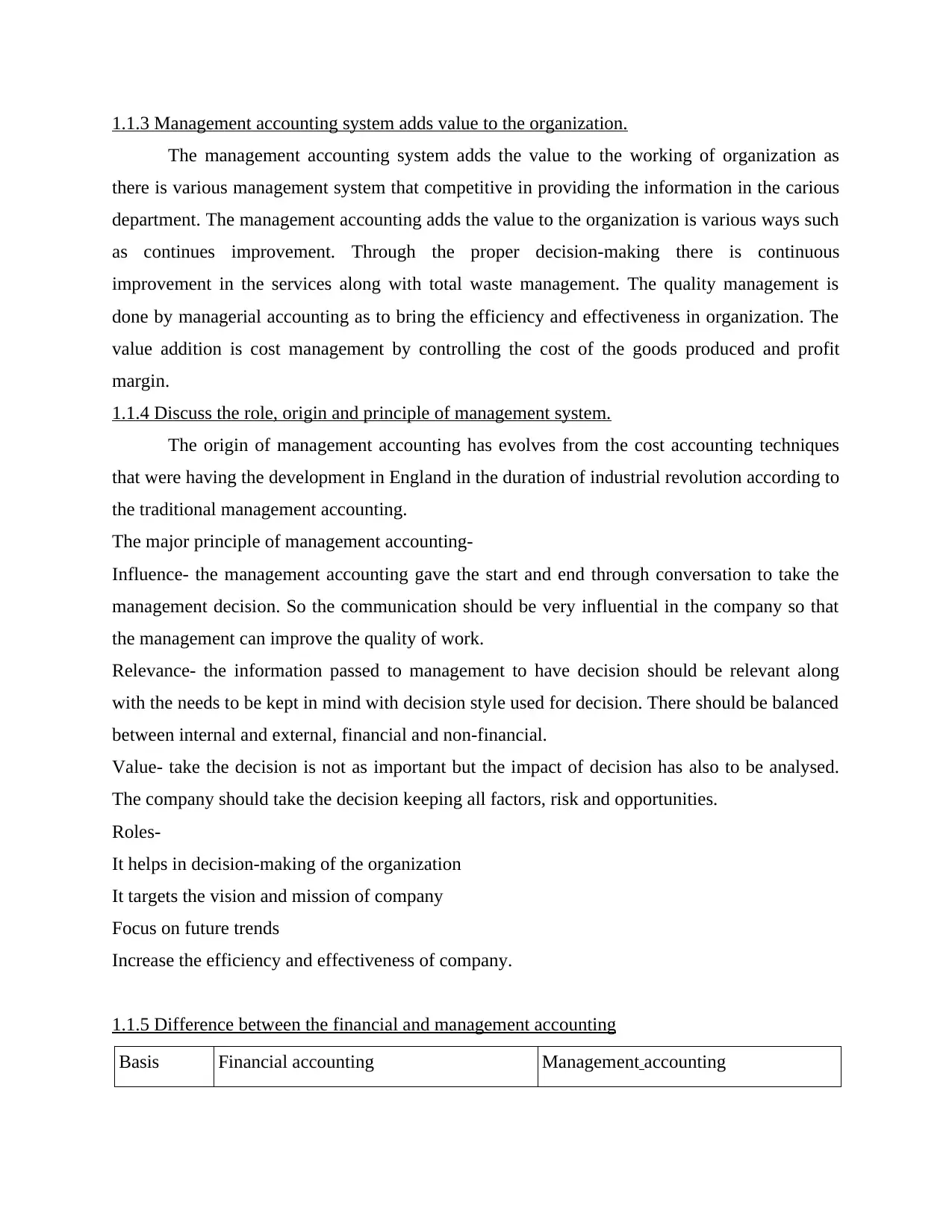
1.1.3 Management accounting system adds value to the organization.
The management accounting system adds the value to the working of organization as
there is various management system that competitive in providing the information in the carious
department. The management accounting adds the value to the organization is various ways such
as continues improvement. Through the proper decision-making there is continuous
improvement in the services along with total waste management. The quality management is
done by managerial accounting as to bring the efficiency and effectiveness in organization. The
value addition is cost management by controlling the cost of the goods produced and profit
margin.
1.1.4 Discuss the role, origin and principle of management system.
The origin of management accounting has evolves from the cost accounting techniques
that were having the development in England in the duration of industrial revolution according to
the traditional management accounting.
The major principle of management accounting-
Influence- the management accounting gave the start and end through conversation to take the
management decision. So the communication should be very influential in the company so that
the management can improve the quality of work.
Relevance- the information passed to management to have decision should be relevant along
with the needs to be kept in mind with decision style used for decision. There should be balanced
between internal and external, financial and non-financial.
Value- take the decision is not as important but the impact of decision has also to be analysed.
The company should take the decision keeping all factors, risk and opportunities.
Roles-
It helps in decision-making of the organization
It targets the vision and mission of company
Focus on future trends
Increase the efficiency and effectiveness of company.
1.1.5 Difference between the financial and management accounting
Basis Financial accounting Management accounting
The management accounting system adds the value to the working of organization as
there is various management system that competitive in providing the information in the carious
department. The management accounting adds the value to the organization is various ways such
as continues improvement. Through the proper decision-making there is continuous
improvement in the services along with total waste management. The quality management is
done by managerial accounting as to bring the efficiency and effectiveness in organization. The
value addition is cost management by controlling the cost of the goods produced and profit
margin.
1.1.4 Discuss the role, origin and principle of management system.
The origin of management accounting has evolves from the cost accounting techniques
that were having the development in England in the duration of industrial revolution according to
the traditional management accounting.
The major principle of management accounting-
Influence- the management accounting gave the start and end through conversation to take the
management decision. So the communication should be very influential in the company so that
the management can improve the quality of work.
Relevance- the information passed to management to have decision should be relevant along
with the needs to be kept in mind with decision style used for decision. There should be balanced
between internal and external, financial and non-financial.
Value- take the decision is not as important but the impact of decision has also to be analysed.
The company should take the decision keeping all factors, risk and opportunities.
Roles-
It helps in decision-making of the organization
It targets the vision and mission of company
Focus on future trends
Increase the efficiency and effectiveness of company.
1.1.5 Difference between the financial and management accounting
Basis Financial accounting Management accounting
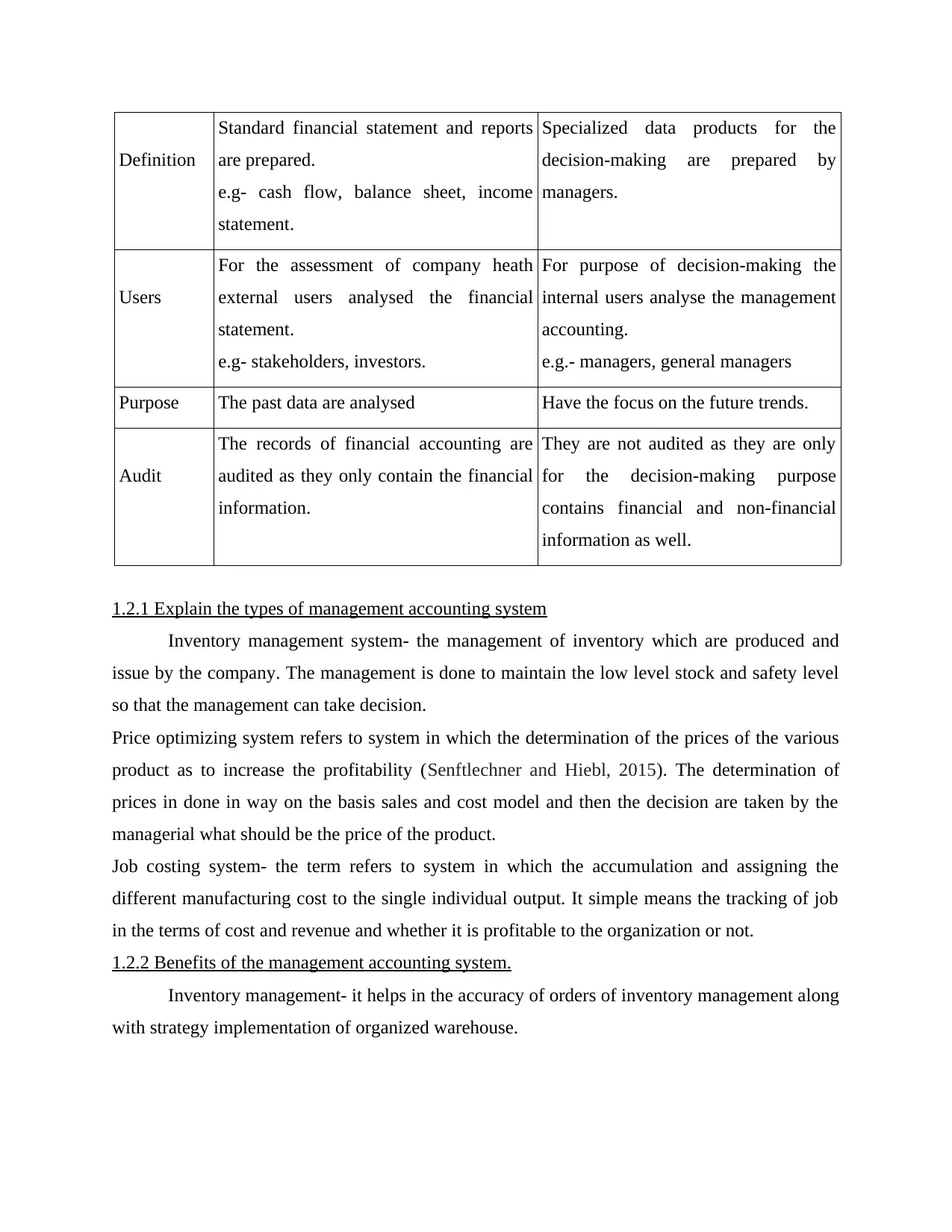
Definition
Standard financial statement and reports
are prepared.
e.g- cash flow, balance sheet, income
statement.
Specialized data products for the
decision-making are prepared by
managers.
Users
For the assessment of company heath
external users analysed the financial
statement.
e.g- stakeholders, investors.
For purpose of decision-making the
internal users analyse the management
accounting.
e.g.- managers, general managers
Purpose The past data are analysed Have the focus on the future trends.
Audit
The records of financial accounting are
audited as they only contain the financial
information.
They are not audited as they are only
for the decision-making purpose
contains financial and non-financial
information as well.
1.2.1 Explain the types of management accounting system
Inventory management system- the management of inventory which are produced and
issue by the company. The management is done to maintain the low level stock and safety level
so that the management can take decision.
Price optimizing system refers to system in which the determination of the prices of the various
product as to increase the profitability (Senftlechner and Hiebl, 2015). The determination of
prices in done in way on the basis sales and cost model and then the decision are taken by the
managerial what should be the price of the product.
Job costing system- the term refers to system in which the accumulation and assigning the
different manufacturing cost to the single individual output. It simple means the tracking of job
in the terms of cost and revenue and whether it is profitable to the organization or not.
1.2.2 Benefits of the management accounting system.
Inventory management- it helps in the accuracy of orders of inventory management along
with strategy implementation of organized warehouse.
Standard financial statement and reports
are prepared.
e.g- cash flow, balance sheet, income
statement.
Specialized data products for the
decision-making are prepared by
managers.
Users
For the assessment of company heath
external users analysed the financial
statement.
e.g- stakeholders, investors.
For purpose of decision-making the
internal users analyse the management
accounting.
e.g.- managers, general managers
Purpose The past data are analysed Have the focus on the future trends.
Audit
The records of financial accounting are
audited as they only contain the financial
information.
They are not audited as they are only
for the decision-making purpose
contains financial and non-financial
information as well.
1.2.1 Explain the types of management accounting system
Inventory management system- the management of inventory which are produced and
issue by the company. The management is done to maintain the low level stock and safety level
so that the management can take decision.
Price optimizing system refers to system in which the determination of the prices of the various
product as to increase the profitability (Senftlechner and Hiebl, 2015). The determination of
prices in done in way on the basis sales and cost model and then the decision are taken by the
managerial what should be the price of the product.
Job costing system- the term refers to system in which the accumulation and assigning the
different manufacturing cost to the single individual output. It simple means the tracking of job
in the terms of cost and revenue and whether it is profitable to the organization or not.
1.2.2 Benefits of the management accounting system.
Inventory management- it helps in the accuracy of orders of inventory management along
with strategy implementation of organized warehouse.
⊘ This is a preview!⊘
Do you want full access?
Subscribe today to unlock all pages.

Trusted by 1+ million students worldwide
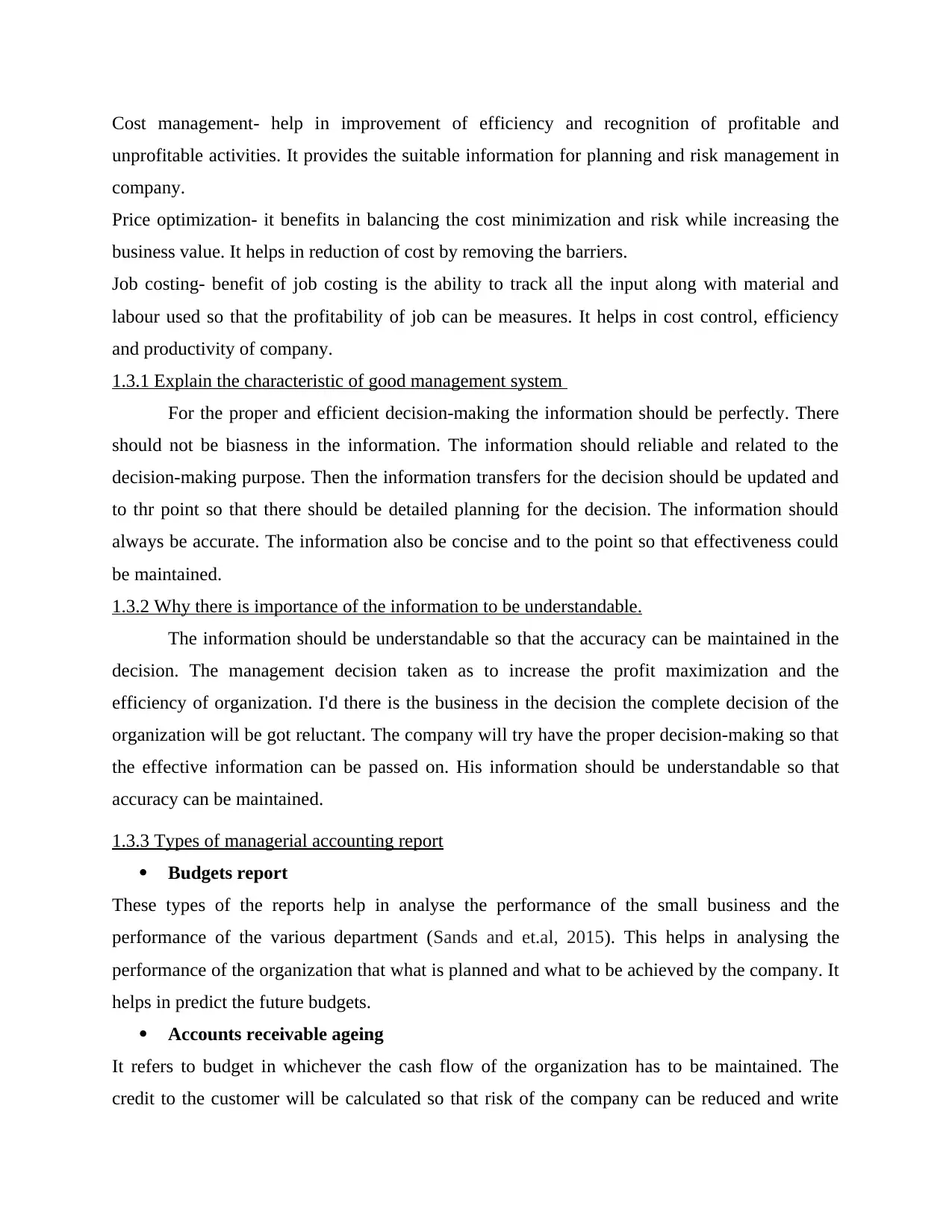
Cost management- help in improvement of efficiency and recognition of profitable and
unprofitable activities. It provides the suitable information for planning and risk management in
company.
Price optimization- it benefits in balancing the cost minimization and risk while increasing the
business value. It helps in reduction of cost by removing the barriers.
Job costing- benefit of job costing is the ability to track all the input along with material and
labour used so that the profitability of job can be measures. It helps in cost control, efficiency
and productivity of company.
1.3.1 Explain the characteristic of good management system
For the proper and efficient decision-making the information should be perfectly. There
should not be biasness in the information. The information should reliable and related to the
decision-making purpose. Then the information transfers for the decision should be updated and
to thr point so that there should be detailed planning for the decision. The information should
always be accurate. The information also be concise and to the point so that effectiveness could
be maintained.
1.3.2 Why there is importance of the information to be understandable.
The information should be understandable so that the accuracy can be maintained in the
decision. The management decision taken as to increase the profit maximization and the
efficiency of organization. I'd there is the business in the decision the complete decision of the
organization will be got reluctant. The company will try have the proper decision-making so that
the effective information can be passed on. His information should be understandable so that
accuracy can be maintained.
1.3.3 Types of managerial accounting report
Budgets report
These types of the reports help in analyse the performance of the small business and the
performance of the various department (Sands and et.al, 2015). This helps in analysing the
performance of the organization that what is planned and what to be achieved by the company. It
helps in predict the future budgets.
Accounts receivable ageing
It refers to budget in whichever the cash flow of the organization has to be maintained. The
credit to the customer will be calculated so that risk of the company can be reduced and write
unprofitable activities. It provides the suitable information for planning and risk management in
company.
Price optimization- it benefits in balancing the cost minimization and risk while increasing the
business value. It helps in reduction of cost by removing the barriers.
Job costing- benefit of job costing is the ability to track all the input along with material and
labour used so that the profitability of job can be measures. It helps in cost control, efficiency
and productivity of company.
1.3.1 Explain the characteristic of good management system
For the proper and efficient decision-making the information should be perfectly. There
should not be biasness in the information. The information should reliable and related to the
decision-making purpose. Then the information transfers for the decision should be updated and
to thr point so that there should be detailed planning for the decision. The information should
always be accurate. The information also be concise and to the point so that effectiveness could
be maintained.
1.3.2 Why there is importance of the information to be understandable.
The information should be understandable so that the accuracy can be maintained in the
decision. The management decision taken as to increase the profit maximization and the
efficiency of organization. I'd there is the business in the decision the complete decision of the
organization will be got reluctant. The company will try have the proper decision-making so that
the effective information can be passed on. His information should be understandable so that
accuracy can be maintained.
1.3.3 Types of managerial accounting report
Budgets report
These types of the reports help in analyse the performance of the small business and the
performance of the various department (Sands and et.al, 2015). This helps in analysing the
performance of the organization that what is planned and what to be achieved by the company. It
helps in predict the future budgets.
Accounts receivable ageing
It refers to budget in whichever the cash flow of the organization has to be maintained. The
credit to the customer will be calculated so that risk of the company can be reduced and write
Paraphrase This Document
Need a fresh take? Get an instant paraphrase of this document with our AI Paraphraser
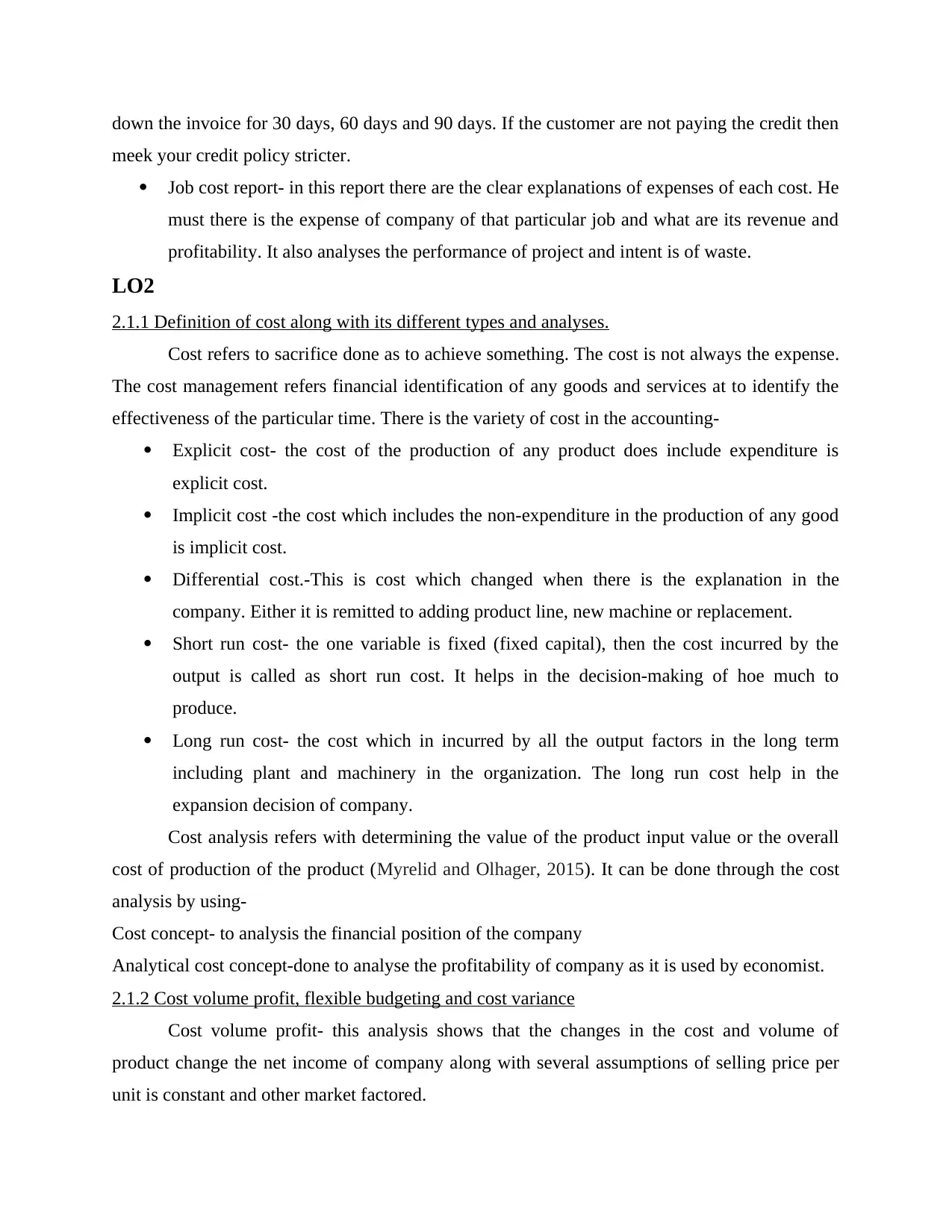
down the invoice for 30 days, 60 days and 90 days. If the customer are not paying the credit then
meek your credit policy stricter.
Job cost report- in this report there are the clear explanations of expenses of each cost. He
must there is the expense of company of that particular job and what are its revenue and
profitability. It also analyses the performance of project and intent is of waste.
LO2
2.1.1 Definition of cost along with its different types and analyses.
Cost refers to sacrifice done as to achieve something. The cost is not always the expense.
The cost management refers financial identification of any goods and services at to identify the
effectiveness of the particular time. There is the variety of cost in the accounting-
Explicit cost- the cost of the production of any product does include expenditure is
explicit cost.
Implicit cost -the cost which includes the non-expenditure in the production of any good
is implicit cost.
Differential cost.-This is cost which changed when there is the explanation in the
company. Either it is remitted to adding product line, new machine or replacement.
Short run cost- the one variable is fixed (fixed capital), then the cost incurred by the
output is called as short run cost. It helps in the decision-making of hoe much to
produce.
Long run cost- the cost which in incurred by all the output factors in the long term
including plant and machinery in the organization. The long run cost help in the
expansion decision of company.
Cost analysis refers with determining the value of the product input value or the overall
cost of production of the product (Myrelid and Olhager, 2015). It can be done through the cost
analysis by using-
Cost concept- to analysis the financial position of the company
Analytical cost concept-done to analyse the profitability of company as it is used by economist.
2.1.2 Cost volume profit, flexible budgeting and cost variance
Cost volume profit- this analysis shows that the changes in the cost and volume of
product change the net income of company along with several assumptions of selling price per
unit is constant and other market factored.
meek your credit policy stricter.
Job cost report- in this report there are the clear explanations of expenses of each cost. He
must there is the expense of company of that particular job and what are its revenue and
profitability. It also analyses the performance of project and intent is of waste.
LO2
2.1.1 Definition of cost along with its different types and analyses.
Cost refers to sacrifice done as to achieve something. The cost is not always the expense.
The cost management refers financial identification of any goods and services at to identify the
effectiveness of the particular time. There is the variety of cost in the accounting-
Explicit cost- the cost of the production of any product does include expenditure is
explicit cost.
Implicit cost -the cost which includes the non-expenditure in the production of any good
is implicit cost.
Differential cost.-This is cost which changed when there is the explanation in the
company. Either it is remitted to adding product line, new machine or replacement.
Short run cost- the one variable is fixed (fixed capital), then the cost incurred by the
output is called as short run cost. It helps in the decision-making of hoe much to
produce.
Long run cost- the cost which in incurred by all the output factors in the long term
including plant and machinery in the organization. The long run cost help in the
expansion decision of company.
Cost analysis refers with determining the value of the product input value or the overall
cost of production of the product (Myrelid and Olhager, 2015). It can be done through the cost
analysis by using-
Cost concept- to analysis the financial position of the company
Analytical cost concept-done to analyse the profitability of company as it is used by economist.
2.1.2 Cost volume profit, flexible budgeting and cost variance
Cost volume profit- this analysis shows that the changes in the cost and volume of
product change the net income of company along with several assumptions of selling price per
unit is constant and other market factored.
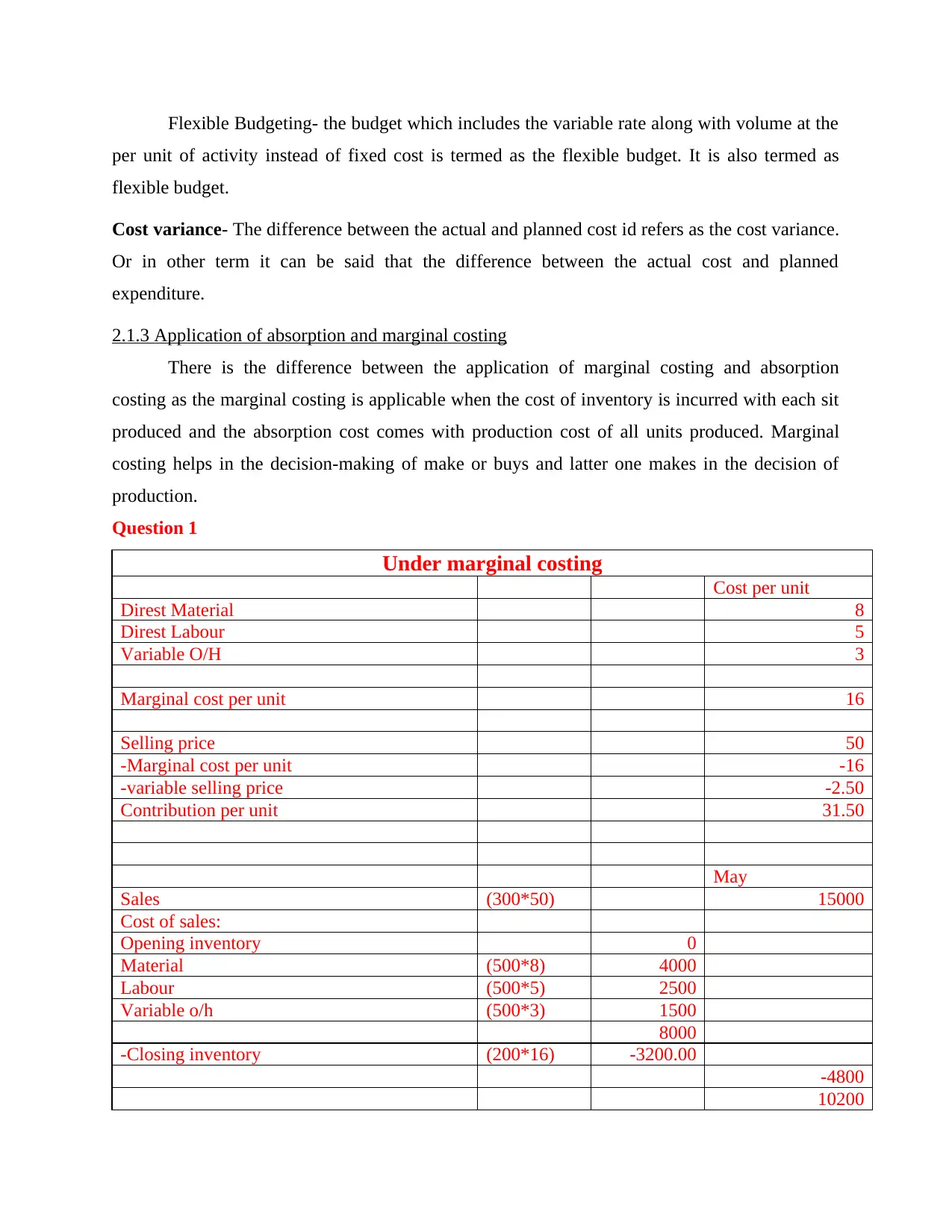
Flexible Budgeting- the budget which includes the variable rate along with volume at the
per unit of activity instead of fixed cost is termed as the flexible budget. It is also termed as
flexible budget.
Cost variance- The difference between the actual and planned cost id refers as the cost variance.
Or in other term it can be said that the difference between the actual cost and planned
expenditure.
2.1.3 Application of absorption and marginal costing
There is the difference between the application of marginal costing and absorption
costing as the marginal costing is applicable when the cost of inventory is incurred with each sit
produced and the absorption cost comes with production cost of all units produced. Marginal
costing helps in the decision-making of make or buys and latter one makes in the decision of
production.
Question 1
Under marginal costing
Cost per unit
Direst Material 8
Direst Labour 5
Variable O/H 3
Marginal cost per unit 16
Selling price 50
-Marginal cost per unit -16
-variable selling price -2.50
Contribution per unit 31.50
May
Sales (300*50) 15000
Cost of sales:
Opening inventory 0
Material (500*8) 4000
Labour (500*5) 2500
Variable o/h (500*3) 1500
8000
-Closing inventory (200*16) -3200.00
-4800
10200
per unit of activity instead of fixed cost is termed as the flexible budget. It is also termed as
flexible budget.
Cost variance- The difference between the actual and planned cost id refers as the cost variance.
Or in other term it can be said that the difference between the actual cost and planned
expenditure.
2.1.3 Application of absorption and marginal costing
There is the difference between the application of marginal costing and absorption
costing as the marginal costing is applicable when the cost of inventory is incurred with each sit
produced and the absorption cost comes with production cost of all units produced. Marginal
costing helps in the decision-making of make or buys and latter one makes in the decision of
production.
Question 1
Under marginal costing
Cost per unit
Direst Material 8
Direst Labour 5
Variable O/H 3
Marginal cost per unit 16
Selling price 50
-Marginal cost per unit -16
-variable selling price -2.50
Contribution per unit 31.50
May
Sales (300*50) 15000
Cost of sales:
Opening inventory 0
Material (500*8) 4000
Labour (500*5) 2500
Variable o/h (500*3) 1500
8000
-Closing inventory (200*16) -3200.00
-4800
10200
⊘ This is a preview!⊘
Do you want full access?
Subscribe today to unlock all pages.

Trusted by 1+ million students worldwide
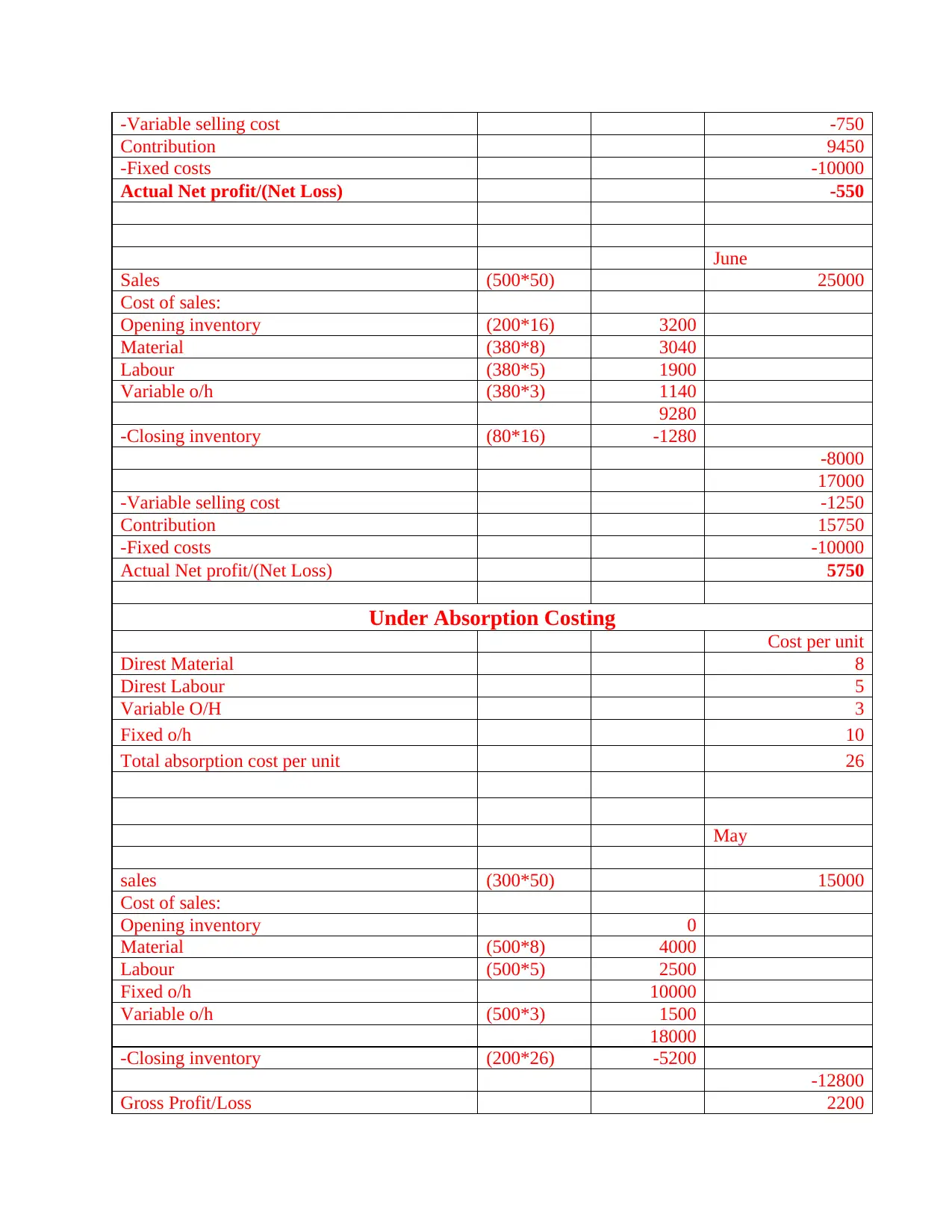
-Variable selling cost -750
Contribution 9450
-Fixed costs -10000
Actual Net profit/(Net Loss) -550
June
Sales (500*50) 25000
Cost of sales:
Opening inventory (200*16) 3200
Material (380*8) 3040
Labour (380*5) 1900
Variable o/h (380*3) 1140
9280
-Closing inventory (80*16) -1280
-8000
17000
-Variable selling cost -1250
Contribution 15750
-Fixed costs -10000
Actual Net profit/(Net Loss) 5750
Under Absorption Costing
Cost per unit
Direst Material 8
Direst Labour 5
Variable O/H 3
Fixed o/h 10
Total absorption cost per unit 26
May
sales (300*50) 15000
Cost of sales:
Opening inventory 0
Material (500*8) 4000
Labour (500*5) 2500
Fixed o/h 10000
Variable o/h (500*3) 1500
18000
-Closing inventory (200*26) -5200
-12800
Gross Profit/Loss 2200
Contribution 9450
-Fixed costs -10000
Actual Net profit/(Net Loss) -550
June
Sales (500*50) 25000
Cost of sales:
Opening inventory (200*16) 3200
Material (380*8) 3040
Labour (380*5) 1900
Variable o/h (380*3) 1140
9280
-Closing inventory (80*16) -1280
-8000
17000
-Variable selling cost -1250
Contribution 15750
-Fixed costs -10000
Actual Net profit/(Net Loss) 5750
Under Absorption Costing
Cost per unit
Direst Material 8
Direst Labour 5
Variable O/H 3
Fixed o/h 10
Total absorption cost per unit 26
May
sales (300*50) 15000
Cost of sales:
Opening inventory 0
Material (500*8) 4000
Labour (500*5) 2500
Fixed o/h 10000
Variable o/h (500*3) 1500
18000
-Closing inventory (200*26) -5200
-12800
Gross Profit/Loss 2200
Paraphrase This Document
Need a fresh take? Get an instant paraphrase of this document with our AI Paraphraser
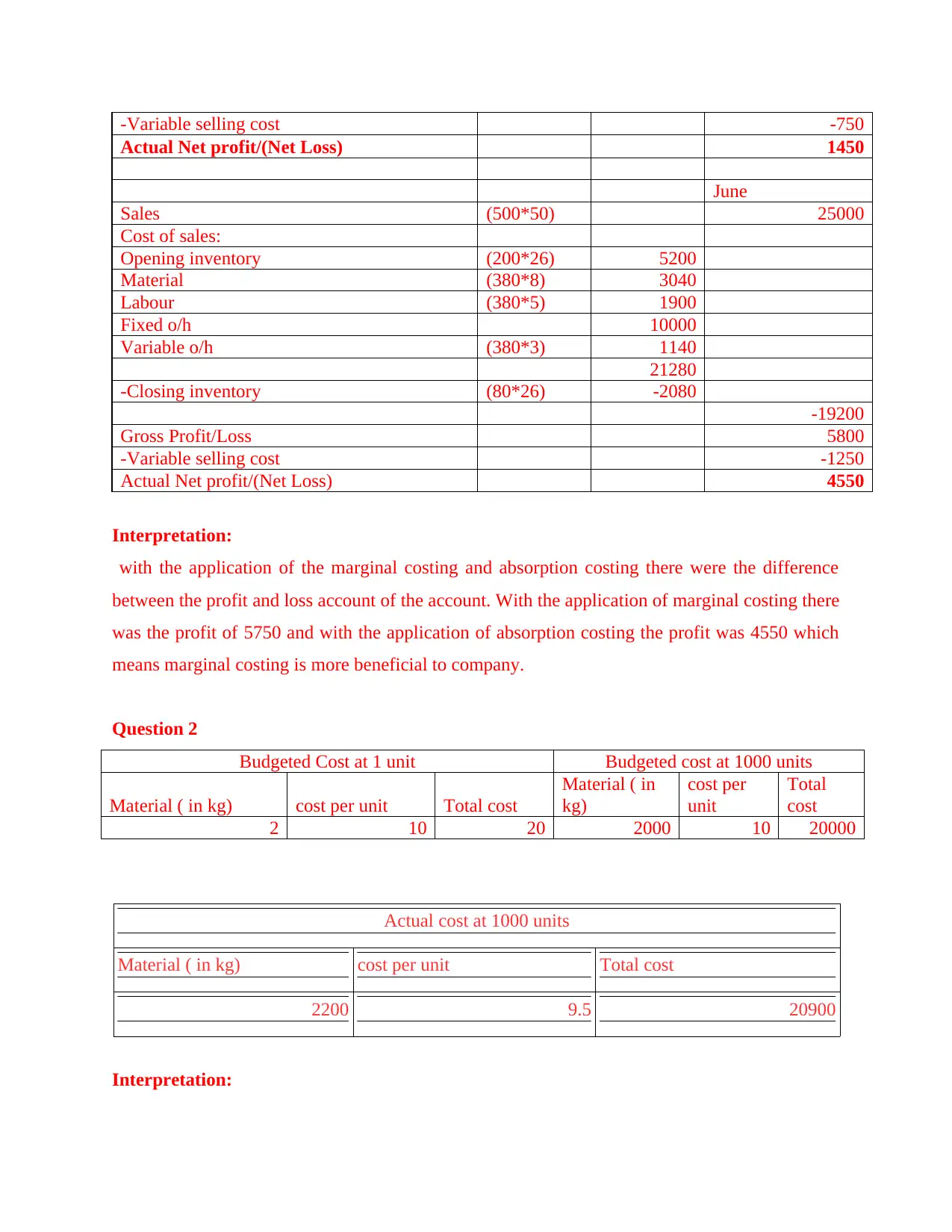
-Variable selling cost -750
Actual Net profit/(Net Loss) 1450
June
Sales (500*50) 25000
Cost of sales:
Opening inventory (200*26) 5200
Material (380*8) 3040
Labour (380*5) 1900
Fixed o/h 10000
Variable o/h (380*3) 1140
21280
-Closing inventory (80*26) -2080
-19200
Gross Profit/Loss 5800
-Variable selling cost -1250
Actual Net profit/(Net Loss) 4550
Interpretation:
with the application of the marginal costing and absorption costing there were the difference
between the profit and loss account of the account. With the application of marginal costing there
was the profit of 5750 and with the application of absorption costing the profit was 4550 which
means marginal costing is more beneficial to company.
Question 2
Budgeted Cost at 1 unit Budgeted cost at 1000 units
Material ( in kg) cost per unit Total cost
Material ( in
kg)
cost per
unit
Total
cost
2 10 20 2000 10 20000
Actual cost at 1000 units
Material ( in kg) cost per unit Total cost
2200 9.5 20900
Interpretation:
Actual Net profit/(Net Loss) 1450
June
Sales (500*50) 25000
Cost of sales:
Opening inventory (200*26) 5200
Material (380*8) 3040
Labour (380*5) 1900
Fixed o/h 10000
Variable o/h (380*3) 1140
21280
-Closing inventory (80*26) -2080
-19200
Gross Profit/Loss 5800
-Variable selling cost -1250
Actual Net profit/(Net Loss) 4550
Interpretation:
with the application of the marginal costing and absorption costing there were the difference
between the profit and loss account of the account. With the application of marginal costing there
was the profit of 5750 and with the application of absorption costing the profit was 4550 which
means marginal costing is more beneficial to company.
Question 2
Budgeted Cost at 1 unit Budgeted cost at 1000 units
Material ( in kg) cost per unit Total cost
Material ( in
kg)
cost per
unit
Total
cost
2 10 20 2000 10 20000
Actual cost at 1000 units
Material ( in kg) cost per unit Total cost
2200 9.5 20900
Interpretation:
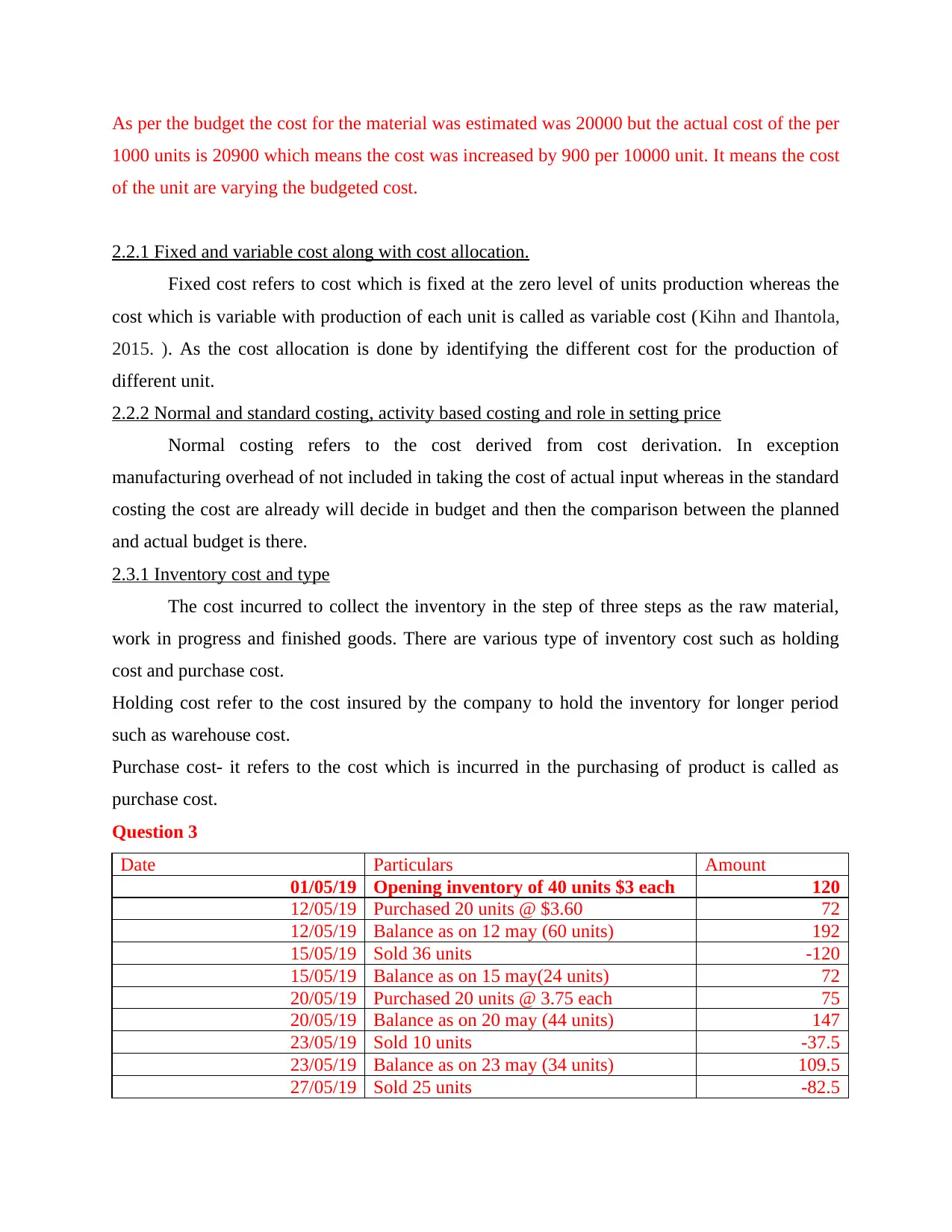
As per the budget the cost for the material was estimated was 20000 but the actual cost of the per
1000 units is 20900 which means the cost was increased by 900 per 10000 unit. It means the cost
of the unit are varying the budgeted cost.
2.2.1 Fixed and variable cost along with cost allocation.
Fixed cost refers to cost which is fixed at the zero level of units production whereas the
cost which is variable with production of each unit is called as variable cost (Kihn and Ihantola,
2015. ). As the cost allocation is done by identifying the different cost for the production of
different unit.
2.2.2 Normal and standard costing, activity based costing and role in setting price
Normal costing refers to the cost derived from cost derivation. In exception
manufacturing overhead of not included in taking the cost of actual input whereas in the standard
costing the cost are already will decide in budget and then the comparison between the planned
and actual budget is there.
2.3.1 Inventory cost and type
The cost incurred to collect the inventory in the step of three steps as the raw material,
work in progress and finished goods. There are various type of inventory cost such as holding
cost and purchase cost.
Holding cost refer to the cost insured by the company to hold the inventory for longer period
such as warehouse cost.
Purchase cost- it refers to the cost which is incurred in the purchasing of product is called as
purchase cost.
Question 3
Date Particulars Amount
01/05/19 Opening inventory of 40 units $3 each 120
12/05/19 Purchased 20 units @ $3.60 72
12/05/19 Balance as on 12 may (60 units) 192
15/05/19 Sold 36 units -120
15/05/19 Balance as on 15 may(24 units) 72
20/05/19 Purchased 20 units @ 3.75 each 75
20/05/19 Balance as on 20 may (44 units) 147
23/05/19 Sold 10 units -37.5
23/05/19 Balance as on 23 may (34 units) 109.5
27/05/19 Sold 25 units -82.5
1000 units is 20900 which means the cost was increased by 900 per 10000 unit. It means the cost
of the unit are varying the budgeted cost.
2.2.1 Fixed and variable cost along with cost allocation.
Fixed cost refers to cost which is fixed at the zero level of units production whereas the
cost which is variable with production of each unit is called as variable cost (Kihn and Ihantola,
2015. ). As the cost allocation is done by identifying the different cost for the production of
different unit.
2.2.2 Normal and standard costing, activity based costing and role in setting price
Normal costing refers to the cost derived from cost derivation. In exception
manufacturing overhead of not included in taking the cost of actual input whereas in the standard
costing the cost are already will decide in budget and then the comparison between the planned
and actual budget is there.
2.3.1 Inventory cost and type
The cost incurred to collect the inventory in the step of three steps as the raw material,
work in progress and finished goods. There are various type of inventory cost such as holding
cost and purchase cost.
Holding cost refer to the cost insured by the company to hold the inventory for longer period
such as warehouse cost.
Purchase cost- it refers to the cost which is incurred in the purchasing of product is called as
purchase cost.
Question 3
Date Particulars Amount
01/05/19 Opening inventory of 40 units $3 each 120
12/05/19 Purchased 20 units @ $3.60 72
12/05/19 Balance as on 12 may (60 units) 192
15/05/19 Sold 36 units -120
15/05/19 Balance as on 15 may(24 units) 72
20/05/19 Purchased 20 units @ 3.75 each 75
20/05/19 Balance as on 20 may (44 units) 147
23/05/19 Sold 10 units -37.5
23/05/19 Balance as on 23 may (34 units) 109.5
27/05/19 Sold 25 units -82.5
⊘ This is a preview!⊘
Do you want full access?
Subscribe today to unlock all pages.

Trusted by 1+ million students worldwide
1 out of 21
Related Documents
Your All-in-One AI-Powered Toolkit for Academic Success.
+13062052269
info@desklib.com
Available 24*7 on WhatsApp / Email
![[object Object]](/_next/static/media/star-bottom.7253800d.svg)
Unlock your academic potential
Copyright © 2020–2025 A2Z Services. All Rights Reserved. Developed and managed by ZUCOL.




